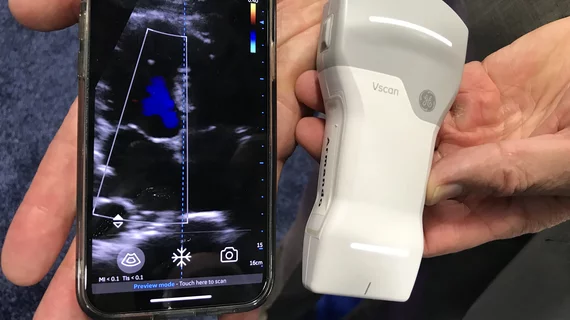Scholarly POCUS judges impressed by handheld models from GE, Philips, EchoNous
Two dozen academic physicians from around the U.S. with expertise in point-of-care ultrasound—and no vested interest in POCUS industry players—recently tested and compared four commercially available POCUS handhelds.
The exercise took place last December during a two-day in-person POCUS continuing medical education course and is described in a study published July 7 by The Ultrasound Journal [1].
Co-corresponding authors Minh-Phuong “Michelle” Le, MD, Lara Voigt, MD, both of UT Health San Antonio, and colleagues from emergency, critical care, hospital, pediatrics and pulmonary medicine acquired three standard POCUS views on the same three standardized patients.
All 24 specialists used all four devices, scoring each on 16 gradable aspects of performance.
No single device emerged as No. 1 in all aspects, although the participants agreed on image quality as their most important characteristic.
The best-rated models in key aspect categories were:
- Overall ease of use: GE Healthcare’s Vscan Air.
- Overall image quality: Philips Healthcare’s Lumify.
- Overall satisfaction: Philips Healthcare’s Lumify.
- Most likely to be purchased personally and carried in one’s coat pocket: GE Healthcare’s Vscan Air.
Also under consideration were Butterfly Network’s Butterfly iQ+ and EchoNous’s Kosmos, which placed as runner-up for overall image quality.
In their discussion, Le, Voight and co-authors suggest their findings have three implications for clinical users of handheld POCUS devices:
1. While Vscan Air was rated highest for overall ease-of-use and Lumify for overall image quality, a perfect handheld device that combines all desired features does not currently exist.”
2. When rating the importance of 16 characteristics of handheld ultrasound devices, only image quality was rated by all 24 experts as being ‘very important.’ Given this, new users should consider giving image quality priority when evaluating devices.”
3. We focused our comparison of handheld ultrasound devices using 2-dimensional imaging alone. However, handheld ultrasound technology is advancing rapidly with new features, including artificial intelligence to guide image acquisition and interpretation, image sharing capabilities for remote teaching and real-time image interpretation by off-site experts and robotics to facilitate probe placement for diagnostic imaging and invasive procedures. … Future studies will be needed to compare the advantages and disadvantages of these advanced technologies in handheld ultrasound devices.”
The authors state they had no competing interests that could have biased their judgments. They also note the project needed no approval from an institutional review board since it was considered non-regulated research.
The study is available in full for free.
More POCUS Coverage:
POCUS access: Urban oases, rural deserts
Homegrown POCUS education for IM residents demonstrated, deemed successful
Cross-sectional imaging ordered downstream for just 15% of emergency POCUS patients
Shortened POCUS curriculum leaves residents long on confidence, short on skills
Ultrasound ‘grand challenge’ launches to promote global POCUS proficiency
FDA greenlights portable, wearable 3D breast POCUS
Global ultrasound ‘bubble community’ rallies around Ukrainian children in need of imaging
Reference:
- Minh-Phuong Le, Lara Voigt, et al., “Comparison of four handheld point-of-care ultrasound devices by expert users.” The Ultrasound Journal, July 7, 2022. DOI: https://doi.org/10.1186/s13089-022-00274-6

